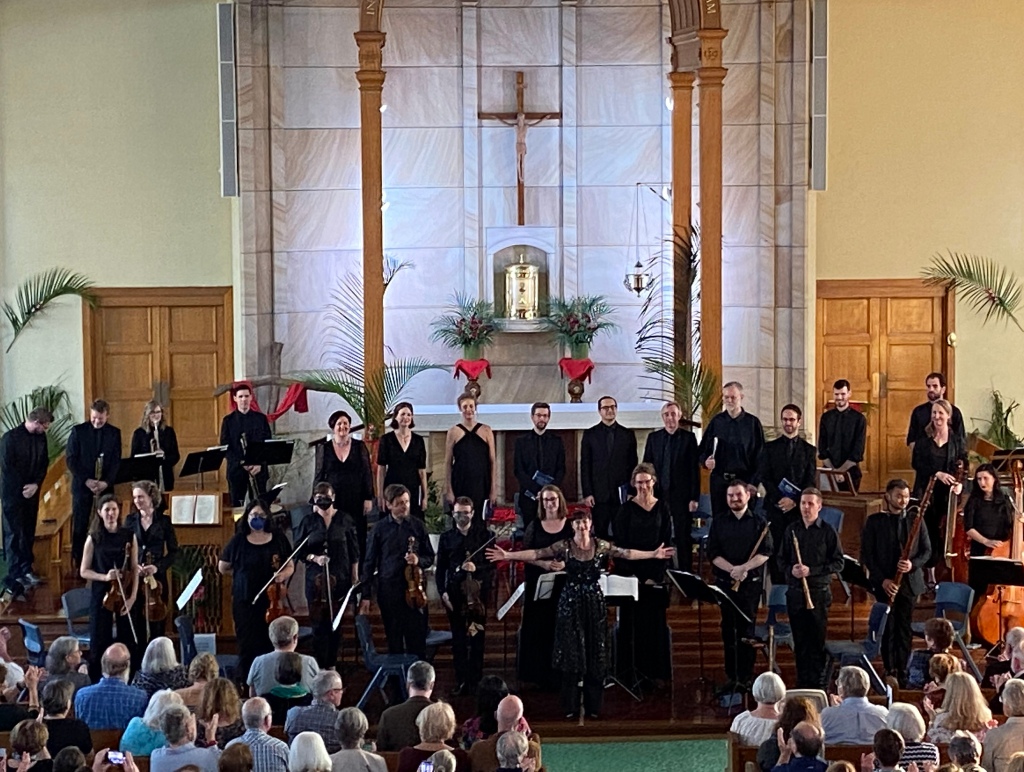
Easter time, as artistic director Madeleine Easton noted in the program and at the opening of the concert, is about duality between death and decay and hope and resurrection. In this Easter celebration, Bach Akademie Australia performs three pieces debuted in Leipzig for Easter 1725, reliving a week of great creativity for Bach nearly 300 years later.
Before the official program began, Easton led the orchestra and choir in a rendition of Johann Sebastian Bach’s “Brich dem Hungrigen dein Brot, BWV 39” dedicated to the people of Ukraine as they continue to suffer under Russian attacks. The piece was short and simple but resonated on multiple levels as it was originally composed by Bach in reaction to the influx of Protestant refugees to Leipzig from Germany. The message was a clear one of compassion and generosity.
Then began the first of the three programmed pieces: “Am Abend aber desselbigen Sabbats, BWV 42”. The piece told a story of hope during hard times in seeking protection from Jesus and it opened with a light and joyful first movement before tenor Richard Butler turned the tone more sombre in the second movement. But this tone quickly turned again with Hannah Fraser’s performance of the alto aria with a bright supporting oboe played by Adam Masters and Kailen Cresp. In the fifth movement, the orchestra fell away to prioritise the narrative of Thomas Flint’s vocals and his particularly expressive performance. Then, in the following movement, the reintroduction of the violins (Stephen Freeman, Tim Willis, Michele O’Young, Meg Cohen, and James Armstrong) lifted Flint’s bass tones into a brighter realm before the gentle, rounded close of the chorale.
The second piece, “Bleib bei uns, denn es will Abend weden, BWV 6”, was an especially dynamic composition for the way the instruments of the orchestra were layered and shifted in and out of focus throughout the movements for differentiation in texture and tone. The opening movement was remarkable for the choir’s repetition of the phrase “Bleib bei uns (Stay with us)” creating an insistent atmosphere both welcoming and tense. The third movement which brought together Fraser, Anna Fraser, and Susannah Lawergren with Anthea Cottee on cello, Laura Vaughan on double bass, Anthony Abouhamad on harpsichord, and Nathan Cox on organ was a really beautiful combination of the classic 18th century sounds with the angelic voices in perfect harmony. The final movement was also lovely in the full and resounding culmination of the choir and orchestra together.
In the second half of the program the players turned to the titular piece, Bach’s “Easter Oratorio, BWV 249”. In the first two of eleven movements, the additional instruments in the orchestra added interesting depth to the composition. For example, the contrast in the first movement between the booming timpani (Timothy Bridgen), the bright trumpets (Richard Fomison, Leanne Sullivan, and Simon Wolnizer), the tinny harpsichord, and the thin violins was multi-layered and engaging whereas the second movement’s hypnotic repetition in the strings and the strong solo oboe was an entirely different experience. In this piece there were also multiple “Recit” movements in which choir members sung single lines or short passages in the persona of Biblical figures like Mary Magdalene, John, and Peter which added both a narrative quality to the performance and an interesting twist on the idea of a theatrical chorus.
Other stand-out movements from “Easter Oratorio” included Lawergren’s aria in the fifth movement where her crystalline voice was supported by a dreamy flute played by Mikaela Oberg as well as the cello, harpsichord, and organ for an overall mesmerising effect. As well as the seventh movement where Oberg swapped to the recorder with Ruth Crosby which gave Butler’s tenor vocals and the sweet, thin violins an earthy quality without overriding the ethereal rhythm. Like the previous piece, this composition demonstrated Bach’s dynamism and his attention to intricate layering of instruments but the added touch of timpani and trumpet was certainly a rousing conclusion to the program.
Bach’s Easter Oratorio was performed at St Francis of Assisi Church on April 8th
To help support Night Writes, please consider tipping.